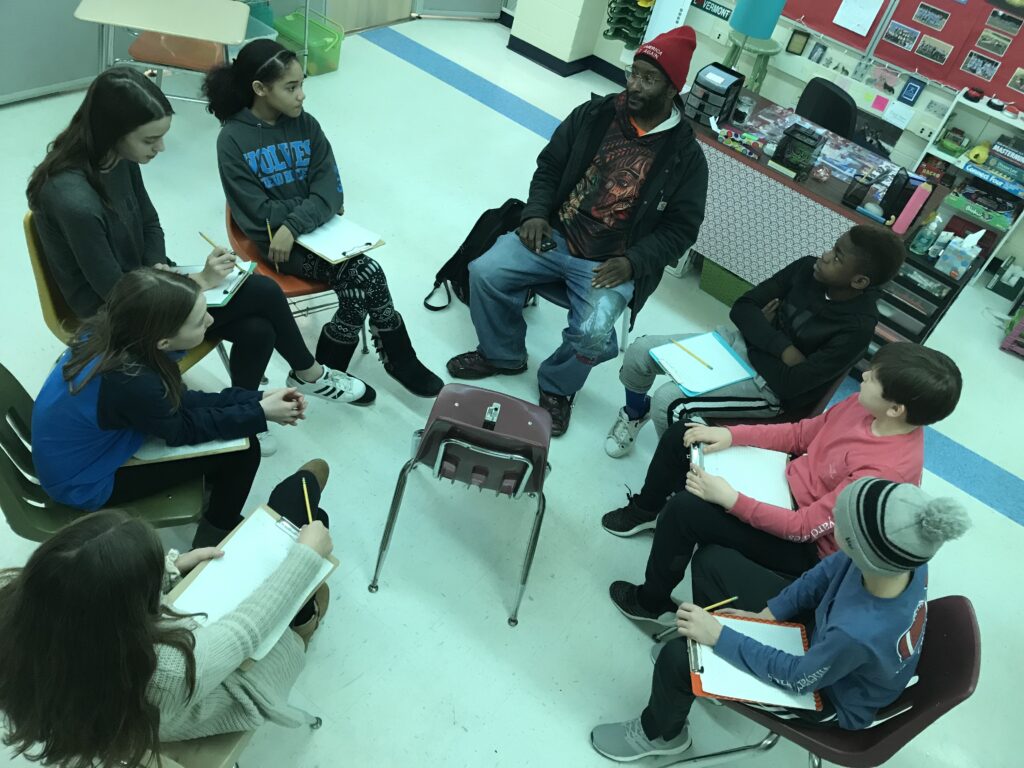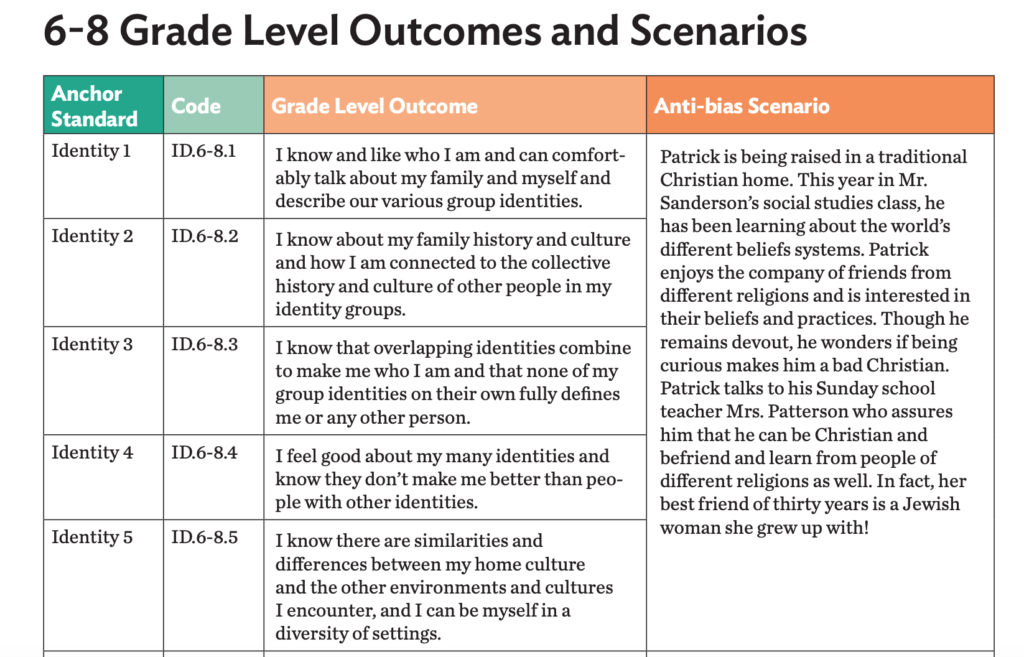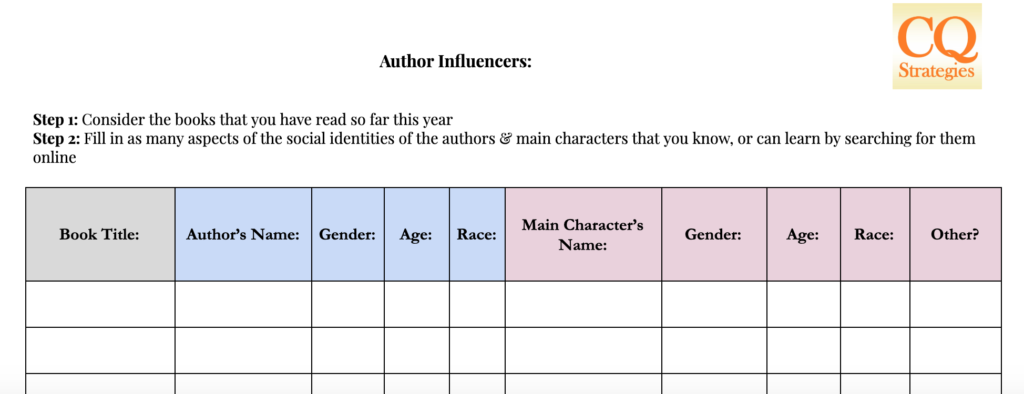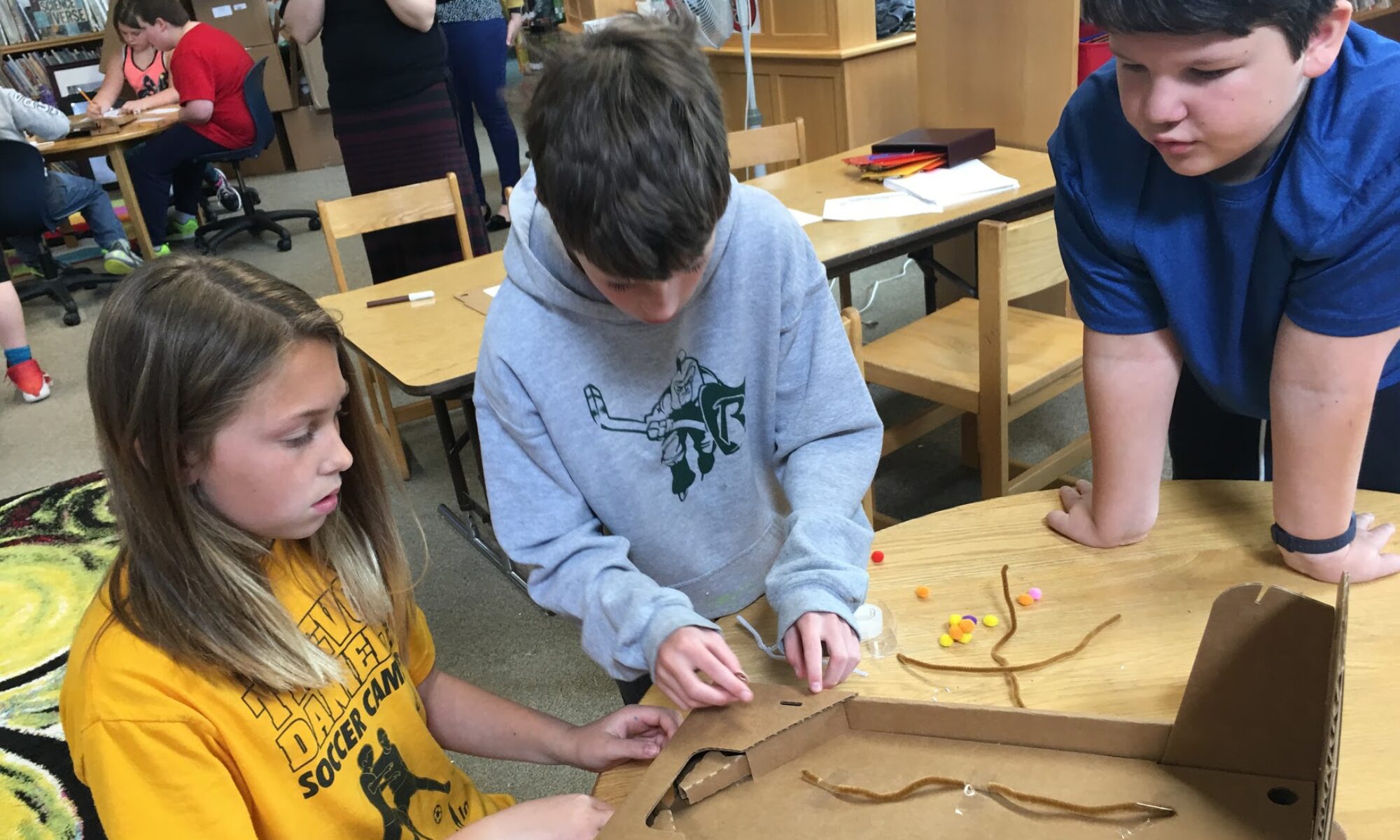Tracing a middle level social identity unit

Identity. Oppression. Social justice. Structural racism. Liberation. These are some intense ideas to grapple with at any age.
Yet 6th grade student Deng isn’t willing to wait: “We need to learn about this stuff early on before it gets pushed off and becomes a problem. We are the next generation of adults.”
Christie Nold and her 6th grade students have tackled these topics together as a courageous learning community that was built intentionally over the course of the year. They showed that not only can young adolescents handle it, but they thrive when given the chance to go deep into identity and equity. Let’s take a peek into Christie’s classroom at Frederick H. Tuttle Middle School in South Burlington, Vermont, to see how she did it, what kids got out of it, and the art they created as a result.
Social identity learning for young adolescents
Young adolescents work hard at figuring out who they are and how they fit into the world. They may not know it, but they are constantly learning about social identity — the way that their concept of self is based on the groups they belong to.
By teaching about social identity in school, Christie sought to provide a safe and supportive environment for students to explore these complex yet deeply personal ideas. She also connected identity to larger ideas about society and history – social inequality, structural racism, Civil Rights.
And finally, she gave students the opportunity to process and to act. At the end of the unit, students worked with teaching artists to express their learning. And what they created was amazing.
Starting with self
Christie wanted students to learn about identity in the context of equity and diversity.
“The impetus for the project was really to allow space for students to engage with who they are as people in the world and what that means and also to engage with folks closer in identity to them or farther in identity from them but either way don’t often represent the trajectory of educators that they have in their lives.”

In addition to the teaching artists, students met guest speakers such as Kiran Waqar, a member of the slam poetry group Muslim Girls Making Change. This inspired two students, Brianna and Zina, to start writing poetry together. Zina noted that Kiran “taught me what it means to stand behind what you really want to say to the world.” Later, the girls were thrilled to work with Rajnii Eddins, who had mentored Muslim Girls Making Change through the Young Writers Project.
Christie also saw the social identity unit as an important first step in her curricular sequence. She wanted students to think about their own identities as a basis for exploring other cultures.
“I find it’s really important to start by knowing ourselves. I think often without a solid understanding of who we are and also an understanding of at least bias if not our own biases it can be really easy to do a unit on cultures and just continue to engage in stereotypical thinking.
And so it was important to me that students have this opportunity to dive pretty hard into who they are and how that informs the way they see the world before they then started looking at other aspects of parts of our world.
Standards-based social identity learning
Christie used the social studies standards as her starting point. The unit addressed standard D2.His.1.6-8 from the College, Career, and Civic Life (C3) Framework for Social Studies State Standards: “Analyze connections among events and developments in broader historical contexts.” The C3 Framework also includes a Sociology Companion Document with competencies such as “Explain the social construction of self and groups.”
Christie knew that the social studies standards had her back. And she knew that she could design a unit that would provide ample opportunities for students to develop Clear and Effective Communication, which was the Transferable Skill she was working on within her proficiency-based classroom.
The Social Justice Standards
For detailed learning targets directly related to social identity, she turned to the Social Justice Standards from Teaching Tolerance. Identity is one of the four major domains of the Social Justice Standards and includes five anchor standards. Christie used the 6-8 outcomes, derived from the anchor standards, to craft her unit.
The Social Justice Standards gave specificity to the framing Christie had already done based on the C3 standards and Transferable Skill proficiencies. And it connected her with resources. She could access resources from Teaching Tolerance such as this PD module on the website or a PD cafe from the magazine. And she could network with educators all over the world who are helping their students dive deep into identity.

Christie received a grant from Teaching Tolerance to fund the teaching artists. But before creating an artistic representation, students delved deeply into the social identity learning.
The arc of the unit
Christie wanted to make sure that her 6th graders were able to engage with complex and intense ideas in a thoroughly supportive environment.
Laying the groundwork
Very early in the unit she introduced resources from the Courageous Conversations protocol which is designed “for effectively engaging, sustaining, and deepening interracial dialogue.” Students explored and upheld the agreements (norms) during discussions and collaboration. And they frequently relied on the Courageous Conversation compass to process intense material by considering whether they were in the feeling, believing, acting, or thinking quadrant.
The classroom community added a norm that basically gave permission to “lie” when exploring identity. When writing, students were told to “put on the page only what you are comfortable putting on the page.” Most of the verbal sharing was also optional. Students controlled what they wanted to disclose. This maintained the personal and intellectual safety of the classroom.
Each trimester I ask the same questions. This is the question I ALWAYS go to first… it is something I find unwaveringly important: pic.twitter.com/5Gf5t2DJeY
— Christie Nold (@ChristieNold) June 11, 2019
Christie also used two read aloud texts to ground the learning throughout the unit. During the first part of the unit that was focused largely on identity, the class read Refugee, by Alan Gratz, which is a story about three young refugees from different nations and eras. During the second part of the unit, the class read Jewell Parker Rhodes’ Ghost Boys, about a young black boy killed by a police officer. Ghost Boys served as a reference point for learning about implicit bias, systemic oppression, and civil rights.
Activities and ideas
With these structures as a backbone, students explored complex concepts by:
- watching this video on the iceberg model of culture and filled out an accompanying worksheet to learn about the explicit and implicit manifestations of culture.
- learning that identity is socially constructed (i.e., it is created in interaction with others).
- looking at various aspects of identity, such as race, gender, sexual orientation, class, and citizenship.
- creating identity pie charts including various social identity and cultural markers, for Refugee characters and then themselves, which they shared with each other if they felt comfortable doing so.
- considering dominant and minoritized identities by watching videos about people featured in Ghost Boys such as Emmet Till and Tamir Rice; then looking at the positionality of aspects of their own identities.
- exploring implicit bias by watching a Trevor Noah clip and then (optionally) taking an Implicit Association Test on race.
- watching and reflecting upon Chimamanda Ngozi Adichie’s Danger of a Single Story Ted Talk about stereotypes.
- examining their social and author influencers and asking “who are we listening to?“
- critiquing bias in advertising by looking at ads that are problematic and ads that are trying to change the paradigm, such as the Gillette ad about the #metoo movement.
- encountering the concept of microaggressions and watching a video about Black parents giving “the talk” to their children.
Take a moment to marvel at the bullets and bolded words above. Consider what a shift it would be for most adults if they took time to learn about these things. Then watch the videos and see how students truly internalized and learned these complex concepts.

Assessment
Christie assessed understanding in several ways. Formatively, in addition to the ongoing reflections and discussions, she has administered a survey three times over the course of the year. The questions were based on the Social Justice Standards. Christie saw significant growth base on student responses.
For summative assessment, students wrote about social identity and made connections to the Ghost Boys book. The performance assessment included a vocabulary bank that students were expected to use in their responses.
Application through art making
After the written performance assessment, students were ready to process and express their learning in a completely different way.
As Christie put it, “I think that because it was so deeply personal and it was about who we are, I wanted to allow students the opportunity to think really expansively. … I had had the opportunity to collect the data and understand how my students were performing. Which then opened up the space for this project to be truly expressive without the confines of an evaluation from me.”
Leading up to the teaching artist experience, students chose the medium that they wanted to explore. Then they connected with a teaching artist for a 45 minute workshop: Rajnii Eddins for spoken word poetry; Max Jennings, a teacher and Moth Grand Slam winner, for oral story telling; or Allison Treston, an art teacher at the school, for visual arts. Students started their projects during the workshops and then used one work day to finish before the exhibition.
One student, Myra, seemed to agree with the non-evaluative approach:
it’s nice to do art because whatever you were doing it’s right because it is about your identity.
Myra created a collage about her identity and shared things that she had never shared at school before. “Identity is not just one thing, it is many things layered on top of each other. … I wanted other kids to learn about who I am and realize that there are parts of me that are different than what they expected.”
I am so deeply blessed. Today was an incredible gift. Our @Tolerance_org grant is working magic through brilliant teaching artists – manifesting in the work & words of our students.
Shared with permission: pic.twitter.com/Q1J220c4Ji
— Christie Nold (@ChristieNold) February 18, 2019
Bonding by performing
Though his hands were shaking beforehand, Jesse was proud to hear his story greeted by gales of laughter. He thought that the art project helped show what he had learned in a different way: “writing an essay would show what you know but telling the story we shared what we have learned about identity. The story was about our identity and an essay would just be about the unit’s identity.”
The exhibition was a powerful example of true student engagement that included emotional, intellectual, and behavioral dimensions. The event perfectly blended deeply personal expression with a public display of deep learning.
And the sense of community was palpable. Yorda noted, “I learned so much from my classmates and it was inspiring to see their passion.”
Deng shared:
My classmates gave me courage because they put out tough stuff about their lives so I thought if they can do it I can do it.
And Will captured the selflessness of a volunteer performer. “I shared my piece not for a response but just to spread awareness and positivity.”

Ready for the tough stuff
Christie’s students impressed Rajnii. He commented that “they seemed particularly primed to explore to a deeper degree issues of our identity and to connect to issues of our humanity in vibrant ways.”
In interviews, students validated Rajnii’s reflection on their readiness and eagerness to learn.
From Abby: “Kids around the world and even younger kids should learn about this because we are the future leaders. Christie and Rajnii are so important because they help us learn about ourselves and let us form our own ideas but that can help us see what we want to do more clearly.”
Yorda agreed that combatting bias should start early:
Young people should learn it so they can teach others. It’s easier to learn when you’re young so you don’t have as many bad biases in your brain yet.
And it’s not just preparation for a far-away future. Many students emphasized how they feel empowered to make change now, through art or otherwise. Brianna observed, “children are not just people who learn something and put it in their mind and put it away, they are ready to think about what’s happening and do something about it.” Zina added, “we might be young but we can make a difference.”
Young adolescents can certainly have an impact, if they are given the knowledge and the opportunity.
Where to start
Christie’s main suggestion for educators who want to help students learn about identity and equity is to look inward first. “Start with self and return to self early and often. And so as much as I am reading about Critical Race Theory, as a white woman I’m reading about whiteness. Understanding what it means to deconstruct the system of whiteness. Not just my White racial identity but the system of whiteness from within myself and within the greater system and world that I move between and around.”
For White educators in particular who want to start by looking inward:
- Books – see White Fragility by Robin Deangelo or Raising Race Questions by Ali Michael.
- Online resources – check out Me and White Supremacy by Layla F. Saad or Building Anti-Racist White Educators.
- Podcasts – listen to Scene on Radio’s Seeing White season or the Teaching While White podcast.
- Hashtags – scroll through #BreakRank.
- Local organizations – attend a meeting of your local Showing Up for Racial Justice (SURJ) chapter.
Here are some resources for anybody interested in moving this direction:
- Books such as Black Appetite, White Food by Jamila Lyiscott or We Got This by Cornelius Minor.
- Conferences like the National Summit for Courageous Conversation or Free Minds, Free People.
- Curricular resources such as those found at Teaching Tolerance, Rethinking Schools, or Zinn Education Project. Here in Vermont please check out the work of local organizations such as Clemmons Family Farm, Community Engagement Lab, and the Vermont Coalition for Ethnic and Social Equity in Schools.
Be gentle with yourself
Christie recommends working in community with others to learn together and care for each other.
One of the things I think I’ve learned in this work is if I think I’ve got it right I don’t. So the closer I am to being convinced that I am doing it in the right way probably the farther I am from doing it right. … a lot of this involves being able to sit in your discomfort and the mess that is trying to undo hundreds of years of systemic racism. Find communities of practice and and folks who are willing to hold one another lovingly accountable. It gets really hard and if you don’t know who those people are.
Christie adds that she is available to connect. “I’m always excited to meet people who are willing to do this work. I think that that is what keeps me going and give me faith and hope. I love meeting other educators who despite how challenging this could be understand that it’s the most important thing that we can do.”
There is a movement afoot in Vermont and beyond to bring these critical conversations into schools. Classrooms like Christie’s show that learning about social identity is not just possible but essential for young adolescents.



Thank you for your sharing. I am worried that I lack creative ideas. It is your article that makes me full of hope. Thank you. But, I have a question, can you help me?
I don’t think the title of your article matches the content lol. Just kidding, mainly because I had some doubts after reading the article.